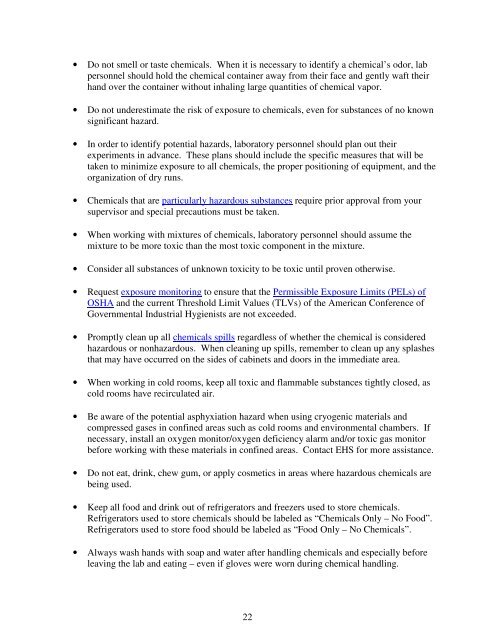Chemical Hygiene Plan - Queensborough Community College ...
Chemical Hygiene Plan - Queensborough Community College ...
Chemical Hygiene Plan - Queensborough Community College ...
You also want an ePaper? Increase the reach of your titles
YUMPU automatically turns print PDFs into web optimized ePapers that Google loves.
• Do not smell or taste chemicals. When it is necessary to identify a chemical’s odor, lab<br />
personnel should hold the chemical container away from their face and gently waft their<br />
hand over the container without inhaling large quantities of chemical vapor.<br />
• Do not underestimate the risk of exposure to chemicals, even for substances of no known<br />
significant hazard.<br />
• In order to identify potential hazards, laboratory personnel should plan out their<br />
experiments in advance. These plans should include the specific measures that will be<br />
taken to minimize exposure to all chemicals, the proper positioning of equipment, and the<br />
organization of dry runs.<br />
• <strong>Chemical</strong>s that are particularly hazardous substances require prior approval from your<br />
supervisor and special precautions must be taken.<br />
• When working with mixtures of chemicals, laboratory personnel should assume the<br />
mixture to be more toxic than the most toxic component in the mixture.<br />
• Consider all substances of unknown toxicity to be toxic until proven otherwise.<br />
• Request exposure monitoring to ensure that the Permissible Exposure Limits (PELs) of<br />
OSHA and the current Threshold Limit Values (TLVs) of the American Conference of<br />
Governmental Industrial Hygienists are not exceeded.<br />
• Promptly clean up all chemicals spills regardless of whether the chemical is considered<br />
hazardous or nonhazardous. When cleaning up spills, remember to clean up any splashes<br />
that may have occurred on the sides of cabinets and doors in the immediate area.<br />
• When working in cold rooms, keep all toxic and flammable substances tightly closed, as<br />
cold rooms have recirculated air.<br />
• Be aware of the potential asphyxiation hazard when using cryogenic materials and<br />
compressed gases in confined areas such as cold rooms and environmental chambers. If<br />
necessary, install an oxygen monitor/oxygen deficiency alarm and/or toxic gas monitor<br />
before working with these materials in confined areas. Contact EHS for more assistance.<br />
• Do not eat, drink, chew gum, or apply cosmetics in areas where hazardous chemicals are<br />
being used.<br />
• Keep all food and drink out of refrigerators and freezers used to store chemicals.<br />
Refrigerators used to store chemicals should be labeled as “<strong>Chemical</strong>s Only – No Food”.<br />
Refrigerators used to store food should be labeled as “Food Only – No <strong>Chemical</strong>s”.<br />
• Always wash hands with soap and water after handling chemicals and especially before<br />
leaving the lab and eating – even if gloves were worn during chemical handling.<br />
22
















